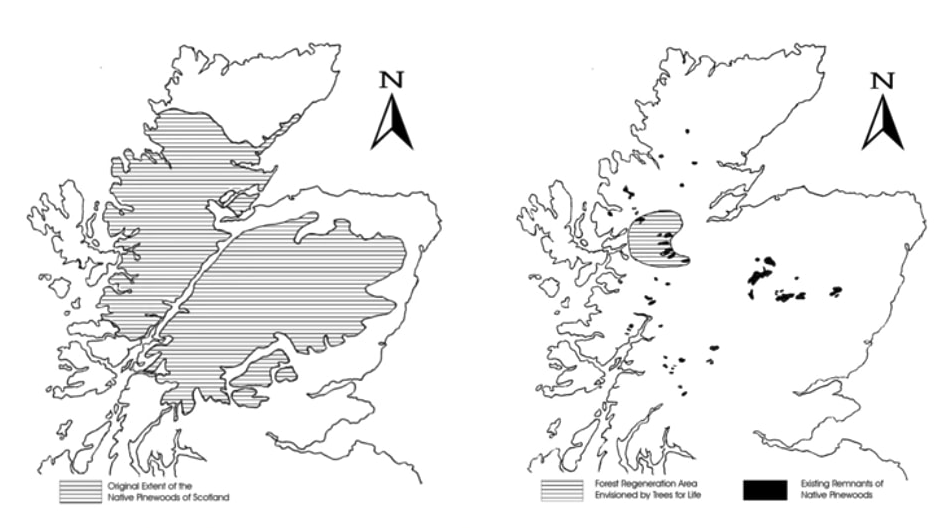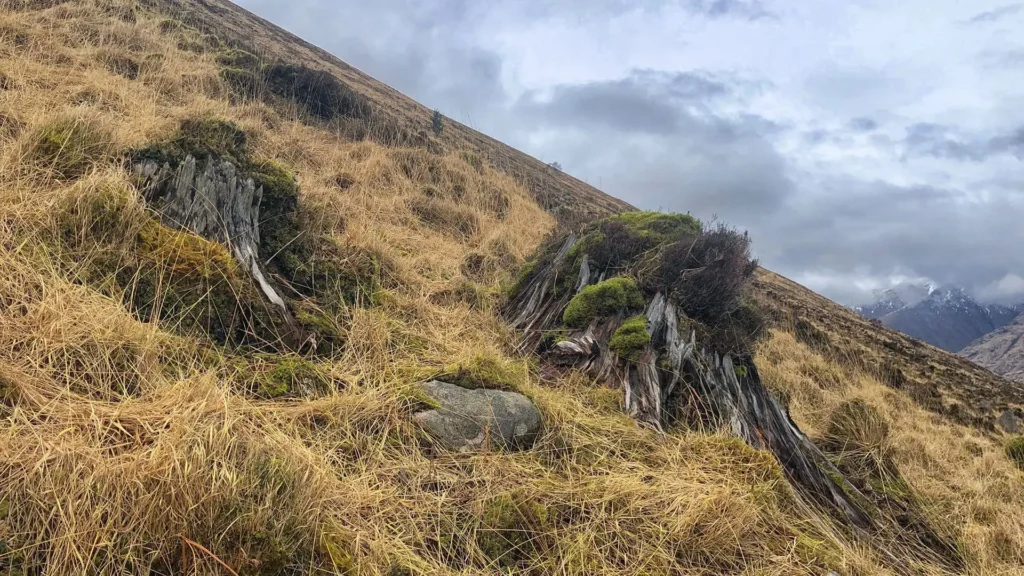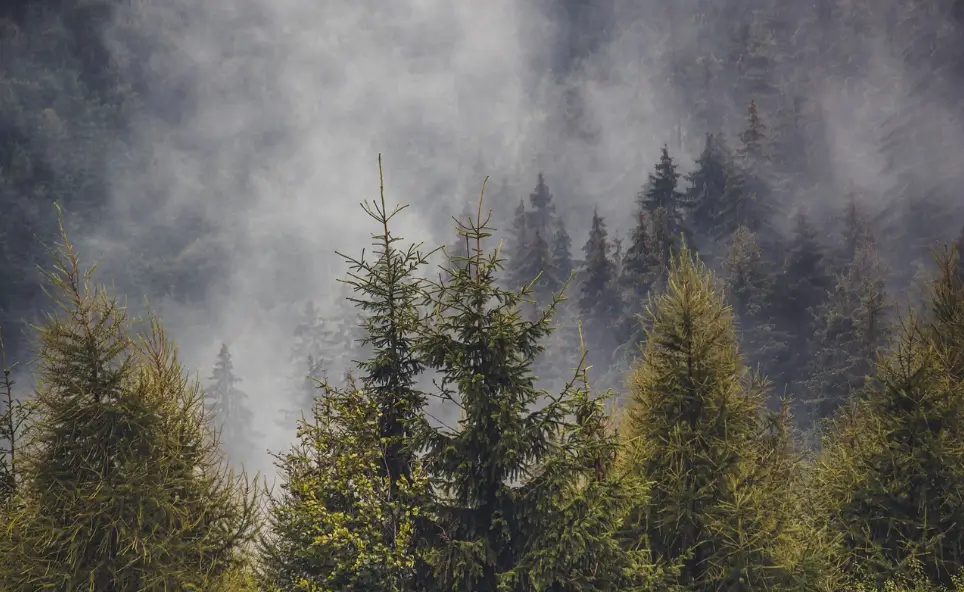Scotland’s native pine forests, once vast in scale and teeming with a plethora of biodiversity, now face critical challenges to their existence after centuries of human & ecological pressures on their natural systems.
Through an array of focused restoration initiatives, Scotland aims to regenerate these vital ecosystems, creating sustainable solutions that benefit both nature and the communities that they benefit.
It is our mission at the Inverness Design Studio to support the important work carried out by the charities and organisations that aim to ensure a better life for our children in a more environmentally sustainable Scotland.
Re-wilding the ancient forests of Scotland is an essential step forward into a more sustainable tomorrow.
Restoring Scotland’s Native Forest Ecosystem
Restoring Scotland’s native forest ecosystem is a complex challenge that requires strategic, multifaceted approaches to balance ecological restoration with mitigating past human impacts. Recent projects led by Forestry and Land Scotland focus on revitalising fragmented ancient woodlands, including rainforests along Lochaber and Cowal, through targeted removal of invasive species like rhododendron and non-native conifers.
These efforts help native species recover and enhance carbon sequestration, contributing to Scotland’s climate commitments For further reading on this, please visit the Forestry and Land Scotland website: Forestry and Land Scotland.
Government strategies, such as the Nature Restoration Fund 2025, provide funding and incentives for landowners and communities to restore woodlands and support biodiversity.
Initiatives by groups like Future Woodlands Scotland work to protect “ghost woodlands” — remnant native woodlands with reduced canopy — and to expand forest cover sustainably. These projects emphasise ecological and economic resilience, integrating woodland expansion with farming and rural livelihoods, enhancing landscape connectivity, and fostering vibrant local ecosystems.
Together, these efforts aim to rebuild Scotland’s ecological and cultural forest heritage for a sustainable future.
By re-wilding the ancient forests of Scotland, we’re playing our part in building a better and more sustainable future for our children.
The Historical Landscape of Scotland’s Forests
Ancient Woodland Legacy
Scotland’s ancient woodlands, particularly its iconic pine forests, represent a deeply rooted ecological and cultural legacy dating back thousands of years. The Scots pine, alongside native species such as birch, oak, and rowan, historically formed vast, interconnected habitats known as the Caledonian Forest. These woodlands supported diverse wildlife, including capercaillies, red squirrels, and other endemic species.
Over millennia, these forests endured natural changes and human influences, with much reduced coverage today—only around 4% of Scotland’s land remains native woodland, much of it fragmented but globally unique.
Many of these trees, especially Scots pines, are descendants of post-glacial populations dating back over 9,000 years, providing an unbroken lineage that reflects Scotland’s natural history and biodiversity. You can read more about Scotland’s ancient Caledonian Forest here: https://en.wikipedia.org/wiki/Caledonian_Forest
The existing pockets of native forest, such as those in the Cairngorms National Park and areas like Loch Arkaig, continue to harbour rare flora and fauna while providing key ecological functions.
Efforts to protect and restore these woodlands honour this ancient heritage by promoting natural regeneration and rewilding, aiming to enhance connectivity and resilience within Scotland’s landscapes. The Loch Arkaig Pine Forest re-wilding is discussed at length in this BBC article: (BBC – Scotland’s Lost Ice Age Pine Woods, Woodland Trust – Loch Arkaig Pine Forest).
These ancient forests remain a vital symbol of Scotland’s wild beauty and ecological richness, central to cultural identity and environmental health.
Centuries of Degradation
The industrial revolution in the 1800’s, agricultural expansion over decades, and unsustainable logging practices led to significant levels of deforestation. By the 20th century, only small, isolated patches of our ancient woodland remained.
The map below illustrates the terminal decline of Scotland’s native pine forests.

Cultural and Ecological Impacts
Beyond the obvious environmental damage, deforestation started to erode Scotland’s cultural connection to its landscapes. The loss of our Caledonian forests displaced communities, disrupted traditional practices, and diminished our biodiversity.
Re-wilding the ancient forests of Scotland will begin to address this imbalance, help drive biodiversity and secure a healthier future for our native species.
Understanding the Current Crisis
Loss of Biodiversity
The absence of our forests has caused the decline of native species that once called Scotland home, leaving many species vulnerable to extinction. Forest-dependent insects, birds, and mammals now struggle to survive.
Overpopulation of Grazing Animals
Deer and sheep populations, unchecked by native predators and large carnivores, prevent the typical process of natural forest regrowth by consuming the seedlings once abundant in the Highlands and the decimation of young plants.
Climate Change Effects
Scotland’s rapidly changing climate exacerbates restoration challenges to those attempting to address them. Altered precipitation patterns, rising sea and air temperatures, and extreme weather events all work in unison to hinder the forest’s natural process of recovery and ecological balance.
The Purpose Behind the Restoration Initiative
Grassroots Beginnings
The initiative began with a creative vision to restore Scotland’s natural landscapes to their former state. Driven by a clear passion and supported by the local communities that call the Highlands home, it seeks to rebuild ecosystems – one step at a time. Re-wilding the ancient forests of Scotland isn’t an overnight fix. It’s a challenge we must all subscribe to if we want Scotland to succeed over the next century.
Long-Term Goals
The long-term goals of rewilding Scotland’s ancient forests centre on recreating a balanced, biodiverse environment that supports thriving plant and animal communities for generations to come.
By restoring native tree cover and reconnecting fragmented habitats, organisations such as Trees for Life and the flagship Affric Highlands project aim to regenerate ecological richness, reverse biodiversity loss, and foster resilience against climate change.
These sustained efforts cultivate mosaics of forests, wetlands, and peatlands, leading to healthy populations of keystone species alongside diverse flora and fauna.
Challenges in Forest Restoration
Grazing Pressures
Managing deer & sheep populations is essential for successful restoration. This however causes many challenges with local communities which rely on these practices. Without intervention, overgrazing will continue to thwart efforts of the mission so a common ground should be found.
Funding and Community Engagement
Securing the necessary resources and fostering public support remain ongoing challenges for the region. Restoration requires a large degree of collaboration between government, organisations, and local residents. Re-wilding the ancient forests of Scotland won’t be cheap but it’s a necessary investment if we want to see our forests thrive.
Climate-Driven Adaptations
As our climate shift, restoration plans must adapt and change their outlook, incorporating resilient species and innovative practices into their long term objectives. Below we can see an example of baron moorland once inhabited by our native Pine forests.

Strategies for Forest Restoration
EDIT on 10/10/24: This video popped up on Youtube after the original article was published.
We found it absolutely moving so now shoe-horning it in. James Watson Featherstone is a true inspiration to all of us in Scotland.
Fencing and Controlled Grazing
Strategic fencing protects seedlings from grazing mammals, allowing young trees to grow undisturbed and flourish in the Highlands.
Encouraging Natural Regeneration
The initiative to promote natural regeneration in Scotland’s ancient forests focuses on safeguarding existing tree stands and adopting forestry practices that work with nature. By encouraging self-seeding and reducing intervention, conservationists rely on the natural dynamics of local habitats to support the growth of new generations of woodland.
Effective strategies include allowing seed-producing parent trees to mature, minimising grazing and browsing pressures—especially by fencing out deer—and letting seeds fall and germinate in suitable conditions. These techniques are highlighted by guidance from Scottish Forestry, which explains how natural regeneration maintains genetic diversity and strengthens woodland resilience.
Landscape-scale projects such as those in Glen Affric and Dundreggan, led by Trees for Life, harness natural regeneration by fencing deer and supporting self-seeding, while supplementing with targeted planting where necessary.
Experts emphasise that natural regeneration is often more cost-effective and ecologically sound than extensive tree planting, as it preserves local adaptations and fosters rich, interconnected habitats (Rewilding Europe – Scottish Highlands).
The ongoing work aligns with the Scottish Government’s broader vision of expanding woodland cover through natural methods, contributing to a self-sustaining, vibrant ecosystem for the future.
Targeted Tree Planting
Native species such as the Scots Pine are planted in areas where regeneration alone cannot restore the natural ecosystems. Tree diversity will ensure long-term resilience against invasive pests and diseases.
Reintroducing Keystone Species
Reintroducing keystone species, such as beavers and wild boars, is central to restoring the ancient forests and strengthening the ecosystem throughout Scotland.
Beavers function as nature’s engineers by constructing dams and wetlands that boost biodiversity, filter water, reduce flooding risk, and create habitats for countless other species; their successful reintroduction to Knapdale Forest has resulted in thriving wetland habitats and positive ecological change (Scotland.org – Beaver Restoration).
Wild boars, on the other hand, aid in dispersing seeds and turning over soil, helping forests to regenerate naturally and maintain healthy undergrowth.
Broader rewilding projects in the Scottish Highlands, notably those led by Trees for Life, manage landscape-scale restoration by combining reintroduction of native species, deer management, and habitat regeneration to sustain a balanced and abundant ecosystem (Rewilding Europe – Scottish Highlands).
These coordinated efforts ensure that not only flagship species such as beavers return, but other vital woodland mammals like pine martens, red squirrels, and birds of prey are supported, contributing to a resilient, self-sustaining environment that benefits wildlife and communities for generations.
Initiatives in the Scottish Highlands fuelling change
There are a number of movements within the Scottish Highlands who aim to bring around real change. Some of these initiatives include:
Trees for lIfe: This project in Glen Affric aims to protect one of the largest areas of Scots Pine in Europe.
Cairngorms Connect: They are behind the largest restoration project of natural habitats in the United Kingdom.
Alladale Wilderness Reserve: A private estate who has a focus on restoring their land’s natural environment.
Ecological and Community Benefits
Revival of Biodiversity
Our restored forests in the Scottish Highlands provide habitats for countless native species, reviving Scotland’s natural heritage of flora & fauna.
Carbon Sequestration Benefits
Trees are well known to absorb CO₂, aiding Scotland’s fight against climate change and aligning with global sustainability goals.
Economic and Cultural Impacts
Re-wilding the ancient forests of Scotland will Revitalise the native forests and boost local tourism in the Scottish Highlands, it will help to create jobs, and foster a real sense of pride within communities. Plus, there are recreational opportunities abound in restored landscapes offered by a more sustainable Scottish Highlands.
There are immeasurable links to negative decline through our geo-diversity within Scotland, which this article explains on NatureScot’s website.
A Vision for the Future
Beyond Tree Planting
True restoration focuses on rebuilding entire ecosystems in Scotland, integrating flora, fauna, and human interactions into a balanced system where all species can benefit equally. Re-wilding the ancient forests of Scotland will help to achieve a balance between those who call the Scottish Highlands their home.
Creating a Resilient Ecosystem
Rewilding the ancient forests of Scotland is a long-term, collaborative endeavour guided by innovations in ecological restoration and community engagement. Initiatives led by groups such as Highlands Rewilding provide practical frameworks for restoring natural habitats, increasing biodiversity, and laying the groundwork for a resilient ecosystem in the Scottish Highlands.
Organisations like Highlands Rewilding and multi-partner projects in the Affric Highlands are championing data-driven strategies to address root causes of environmental decline, reintroduce native tree species, and foster carbon capture, all while creating economic opportunities through nature-based enterprises.
These strategies include large-scale tree planting, innovative seed dispersal techniques, and supporting local stewardship to nurture a thriving, self-sustaining forest for the benefit of everyone in Scotland.
Central to these projects is a commitment to inclusivity and education, highlighted by community-focused rewilding centres such as the Dundreggan Rewilding Centre and charity partners like Trees for Life.
These hubs bring conservation, learning, and participation together, enabling citizens and visitors to take an active role in ecological recovery. By combining modern ecological science and local knowledge, Scotland is pioneering a re-wilding model that creates a greener landscape, enhances wildlife habitat, and strengthens its natural heritage for future generations to enjoy and protect.
Frequently Asked Questions (FAQs)
1. What are Scotland’s native tree species?
Some of the most common native species to Scotland are Scots pine, birch, oak, rowan, and hazel. They are vital for ecosystem restoration moving forward.
2. How does reforestation in the Scottish Highlands impact climate change?
Reforestation plays a critical role in absorbing carbon dioxide, it helps to combat soil erosion, and restores essential water cycles, contributing to climate resilience for the Scottish Highlands and the planet as a whole.
3. Can individuals participate in restoration projects in the Scottish Highlands?
Yes, many organisations offer volunteer opportunities, including tree planting and habitat maintenance.
4. What role do keystone species play?
Keystone species like beaver & wild boar enhance our ecosystems by creating native wetlands, dispersing seeds over a large area, and maintaining healthy levels of biodiversity in our ecosystems. By re-wilding the ancient forests of Scotland, we’re helping to support balance in regions where un-natural systems have proliferated over the last centuries.
5. How long does forest restoration take?
Restoration timelines vary greatly as do scientific projections but can often span decades to achieve fully mature, self-sustaining forests. By acting now we are preparing future generations to live in a more abundant and healthier environment in the Scottish Highlands.
You can follow Andrew Watson Featherstone’s blog from the following link: https://alanwatsonfeatherstone.com/blog



